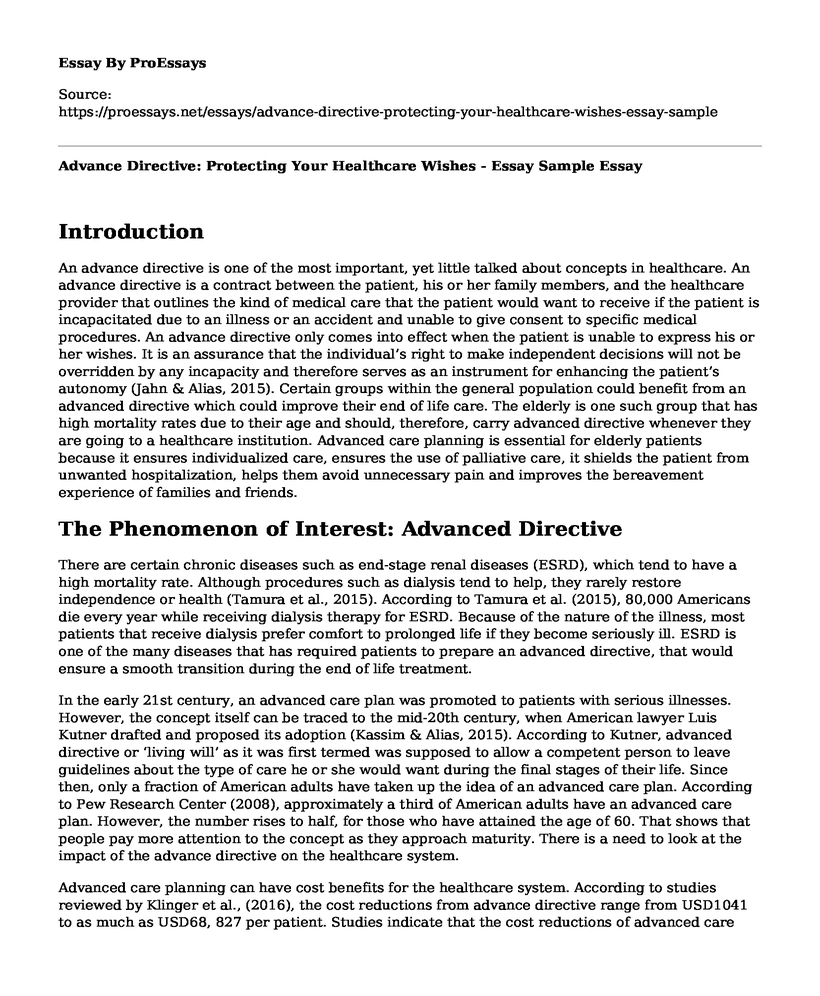Introduction
An advance directive is one of the most important, yet little talked about concepts in healthcare. An advance directive is a contract between the patient, his or her family members, and the healthcare provider that outlines the kind of medical care that the patient would want to receive if the patient is incapacitated due to an illness or an accident and unable to give consent to specific medical procedures. An advance directive only comes into effect when the patient is unable to express his or her wishes. It is an assurance that the individual’s right to make independent decisions will not be overridden by any incapacity and therefore serves as an instrument for enhancing the patient’s autonomy (Jahn & Alias, 2015). Certain groups within the general population could benefit from an advanced directive which could improve their end of life care. The elderly is one such group that has high mortality rates due to their age and should, therefore, carry advanced directive whenever they are going to a healthcare institution. Advanced care planning is essential for elderly patients because it ensures individualized care, ensures the use of palliative care, it shields the patient from unwanted hospitalization, helps them avoid unnecessary pain and improves the bereavement experience of families and friends.
The Phenomenon of Interest: Advanced Directive
There are certain chronic diseases such as end-stage renal diseases (ESRD), which tend to have a high mortality rate. Although procedures such as dialysis tend to help, they rarely restore independence or health (Tamura et al., 2015). According to Tamura et al. (2015), 80,000 Americans die every year while receiving dialysis therapy for ESRD. Because of the nature of the illness, most patients that receive dialysis prefer comfort to prolonged life if they become seriously ill. ESRD is one of the many diseases that has required patients to prepare an advanced directive, that would ensure a smooth transition during the end of life treatment.
In the early 21st century, an advanced care plan was promoted to patients with serious illnesses. However, the concept itself can be traced to the mid-20th century, when American lawyer Luis Kutner drafted and proposed its adoption (Kassim & Alias, 2015). According to Kutner, advanced directive or ‘living will’ as it was first termed was supposed to allow a competent person to leave guidelines about the type of care he or she would want during the final stages of their life. Since then, only a fraction of American adults have taken up the idea of an advanced care plan. According to Pew Research Center (2008), approximately a third of American adults have an advanced care plan. However, the number rises to half, for those who have attained the age of 60. That shows that people pay more attention to the concept as they approach maturity. There is a need to look at the impact of the advance directive on the healthcare system.
Advanced care planning can have cost benefits for the healthcare system. According to studies reviewed by Klinger et al., (2016), the cost reductions from advance directive range from USD1041 to as much as USD68, 827 per patient. Studies indicate that the cost reductions of advanced care planning range from 68% to 5% (Klinger et al., 2016). Such numbers from scientific studies indicate that more people must join advance directive programs because it could result in cost savings for the healthcare system. Well-communicated advanced care assists the patients to accept and counter complex issues in healthcare and encourage them to take charge of their end-of-life care. As a result, the resulting actions from advanced care planning helps with the reduction of healthcare costs, while preserving patient’s dignity and increase the quality of care that they receive. The study by Klinger et al. (2016), indicates that the most significant cost reductions come from rather sick patient populations that used a considerable amount of hospital care.
References
Jahn Kassim, P. N., & Alias, F. (2015). Advance directives for medical treatment: the current legal status. Malayan Law Journal, 3, i-xx. https://www.researchgate.net/publication/281219681_Advance_Directives_for_Medical_Treatment_The_Current_Legal_Status
Klingler, C., in der Schmitten, J., & Marckmann, G. (2016). Does facilitated Advance Care Planning reduce the costs of care near the end of life? Systematic review and ethical considerations. Palliative Medicine, 30(5), 423-433. HYPERLINK "https://journals.sagepub.com/doi/pdf/10.1177/0269216315601346" https://journals.sagepub.com/doi/pdf/10.1177/0269216315601346
Pew Research Center. (2020, May 30). Strong Public Support for Right to Die. Retrieved June 10, 2020, from https://www.people-press.org/2006/01/05/strong-public-support-for-right-to-die/
Tamura, M. K., Montez-Rath, M. E., Hall, Y. N., Katz, R., & O’Hare, A. M. (2017). Advance directives and end-of-life care among nursing home residents receiving maintenance dialysis. Clinical Journal of the American Society of Nephrology, 12(3), 435-442. https://cjasn.asnjournals.org/content/clinjasn/12/3/435.full.pdf
Cite this page
Advance Directive: Protecting Your Healthcare Wishes - Essay Sample. (2023, Aug 28). Retrieved from https://proessays.net/essays/advance-directive-protecting-your-healthcare-wishes-essay-sample
If you are the original author of this essay and no longer wish to have it published on the ProEssays website, please click below to request its removal:
- Factors Affecting the Frequency of Diseases
- ICU Ethics Essay
- The Therapeutic Use of Narrative Therapy With Oncology Patients Paper Example
- The Concept of Pain in Nursing - Paper Example
- Essay Example on COVID-19 Impact: US vs. Canada - Uncompared Statistics and Unequal Outcomes
- Paper Example on Herbal Plants: Natural Sources of Safer Therapeutic Treatments
- Essay Example on Diabetes: A Global Health Crisis Affecting 415 Million & Rising







